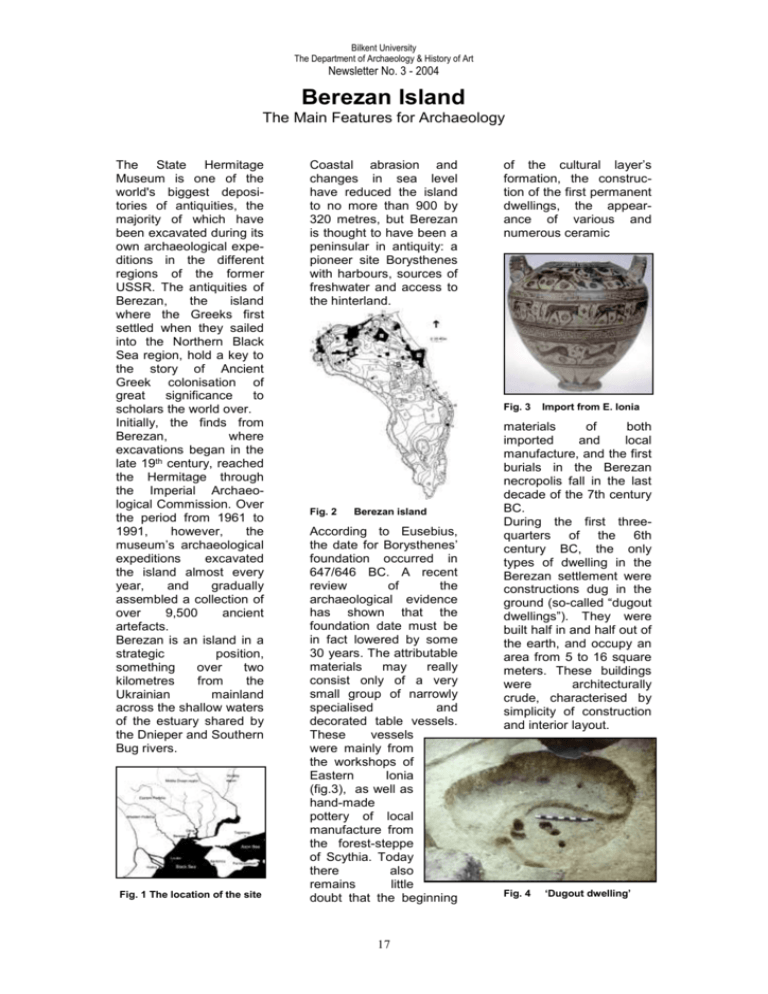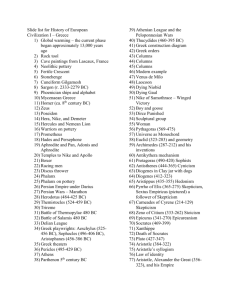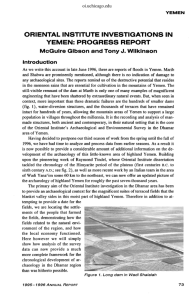Berezan Island - Bilkent University
advertisement

Bilkent University The Department of Archaeology & History of Art Newsletter No. 3 - 2004 Berezan Island The Main Features for Archaeology The State Hermitage Museum is one of the world's biggest depositories of antiquities, the majority of which have been excavated during its own archaeological expeditions in the different regions of the former USSR. The antiquities of Berezan, the island where the Greeks first settled when they sailed into the Northern Black Sea region, hold а key to the story of Ancient Greek colonisation of great significance to scholars the world over. Initially, the finds from Berezan, where excavations began in the late 19th century, reached the Hermitage through the Imperial Archaeological Commission. Over the period from 1961 to 1991, however, the museum’s archaeological expeditions excavated the island almost every year, and gradually assembled а collection of over 9,500 ancient artefacts. Berezan is an island in а strategic position, something over two kilometres from the Ukrainian mainland across the shallow waters of the estuary shared by the Dnieper and Southern Bug rivers. Fig. 1 The location of the site Coastal abrasion and changes in sea level have reduced the island to no more than 900 by 320 metres, but Berezan is thought to have been а peninsular in antiquity: а pioneer site Borysthenes with harbours, sources of freshwater and access to the hinterland. of the cultural layer’s formation, the construction of the first permanent dwellings, the appearance of various and numerous ceramic Fig. 3 Fig. 2 Berezan island According to Eusebius, the date for Borysthenes’ foundation occurred in 647/646 BC. A recent review of the archaeological evidence has shown that the foundation date must be in fact lowered by some 30 years. The attributable materials may really consist only of a very small group of narrowly specialised and decorated table vessels. These vessels were mainly from the workshops of Eastern Ionia (fig.3), as well as hand-made pottery of local manufacture from the forest-steppe of Scythia. Today there also remains little doubt that the beginning 17 Import from E. Ionia materials of both imported and local manufacture, and the first burials in the Berezan necropolis fall in the last decade of the 7th century BC. During the first threequarters of the 6th century BC, the only types of dwelling in the Berezan settlement were constructions dug in the ground (so-called “dugout dwellings”). They were built half in and half out of the earth, and occupy an area from 5 to 16 square meters. These buildings were architecturally crude, characterised by simplicity of construction and interior layout. Fig. 4 ‘Dugout dwelling’ Bilkent University The Department of Archaeology & History of Art Newsletter No. 3 - 2004 The basic distinction among dugout constructions lies in the form of the building: the layout may be quadrangular, oval, or circular. Nearly 200 such dwellings have been found up to the present time. Fragments of trade amphorae (especially from Klasomenae, Chios, Lesbos, Miletus, and Attica) made up the largest part of the numerous finds from these buildings (up to 80% of all pottery fragments). Leaving amphorae out of account, the ratio of imported Greek to local handmade pottery was approximately 80%:20%. Work tools and ornaments, found in large numbers in the settlement, are mostly linked to local cultures. From all of this we may suppose that the Berezan population of the first three-quarters of the 6th century BC was predominantly non-Greek in composition. Cardinal changes in the cultural face of the Berezan settlement took place at the end of the third quarter of the 6th century BC. During a very short time the whole territory of the settlement was built up with above ground homes of generally Greek types (fig. 5). As has been established, this was preceded by preparatory work to level the surface of areas designated for above ground construction. The newly erected houses possessed from 100 to 300 square meters of space and consisted of a few living and household rooms that were grouped differently about an interior courtyard. Depending on their designated purpose, the rooms held stoves, hearths, portable braziers, a heating system of the fireplace type, paving, and drains. In the courtyards, partially paved with fragments of pottery and small stones, were located wells, root cellars, altars, and drains. The houses were most likely single-floor, although the wall construction of Berezan buildings would not prevent the construction of a second floor. The quality of the construction work varied and it seems to depend on the wellbeing of the homeowner. 18 Fig. 5 Late 6th c. Berezan On the whole, construction techniques were of a fairly high level. The architectural appearance of the Berezan houses indicates the urban character of the construction. All the dwelling-places of the Berezan settlement were grouped in blocks of eight or more houses. The area of such a block approached 2000 square meters. The size and placement of the blocks were regulated by a developed network of streets, which was evidently set up from the beginning to an approximately regular plan. Regulation of the area of the settlement occupied by above ground buildings Bilkent University The Department of Archaeology & History of Art Newsletter No. 3 - 2004 evidently did not extend to the outskirts, where dugout construction continued, although to a significantly lesser extent than before. Evidently the former inhabitants of the Berezan settlement abandoned the peninsula in a peaceful way, not due to any violence on the part of the Greeks, possibly upon the conclusion of an agreement between the settlers and native leaders. Such an agreement may have included payment of redemption fees or some other obligation for the land granted to the Greek colonists, probably for an unlimited period of time. Perhaps, only a very small number of the former inhabitants of Berezan remained living on the peninsula. These people were possibly involved in construction work at the new city or had some other relationship with the new inhabitants. By the end of the first third of the 5th century BC Borysthenes had reached its greatest dimensions, never attained before or since. The construction work on Borysthenes reached its peak, which undoubtedly gave it the characteristic features of a classical city. Cardinal changes developed in practically the entire cultural sphere of the Berezan settlement. Most significant was the growth of the specific gravity of wheeled pottery – cooking ware and tableware. From this time forward, most of this pottery consisted of products from Athenian workshops (not only of ← Previous article the highly artistic kind, but also mass-produced). This type of product gradually supplanted Ionian pottery in the daily lives of the inhabitants of Borysthenes. Excluded from this process were of course the amphorae produced by Ionian potters. It is well known that wine was in huge demand in the Fig. 6 Berezan necropolis marketplaces of the northern Black Sea region, sought after by both Greeks and natives. The amount of handmade pottery in the ceramic complex of Berezan declined substantially in comparison with earlier times. One further very important change of this time consisted in the fact that the spiritual life of Borysthenes inhabitants now took on typically Greek characteristics. Primary among these characteristics is traces of Greek cults. The single known cult construction on Berezan – the temple 17 of Aphrodite – was erected at this same time. The excavated part of Berezan necropolis mainly belongs to this period (fig. 6). Most of graves for one type of funeral rites were inhumations in pits of various designs and dimensions. Bodies in their majority were laid extended on their back with head to the North or the East. Only some of them had flexed positions and were oriented otherwise. About 10% of the burials were cremations. Child interments were usually made in big vessels such as amphorae or pithoi. There were also uncovered the remnants of funeral feasts. It is known that the changes in life at Borysthenes occurred at the end of the first third of the 5th century BC. These changes led to the decline of construction work, a sharp reduction in the area of above ground building and an increasing amount of dugout construction. Certain sections of the urban, and possibly rural, Berezan population may have overflowed into Olbia – another Ancient Greek centre of the region. The entire later existence of ancient Berezan is the history of an ordinary agricultural and fishing settlement, not very visible against the background of other rural populated points of the Olbia polis. Curator of Berezan Collection Department of Greek and Roman Antiquities The State Hermitage Museum 34, Dvortsovaya nab. St. Petersburg 190000 Russia Dr. Sergey L. Solovyov Next article →








